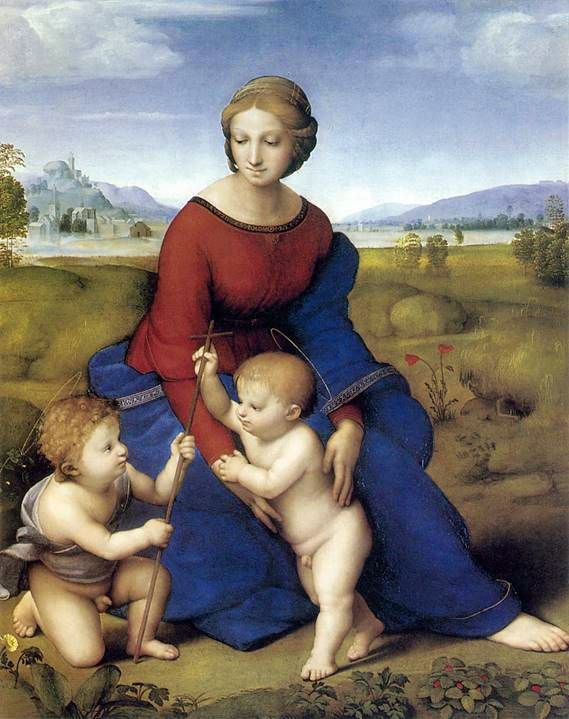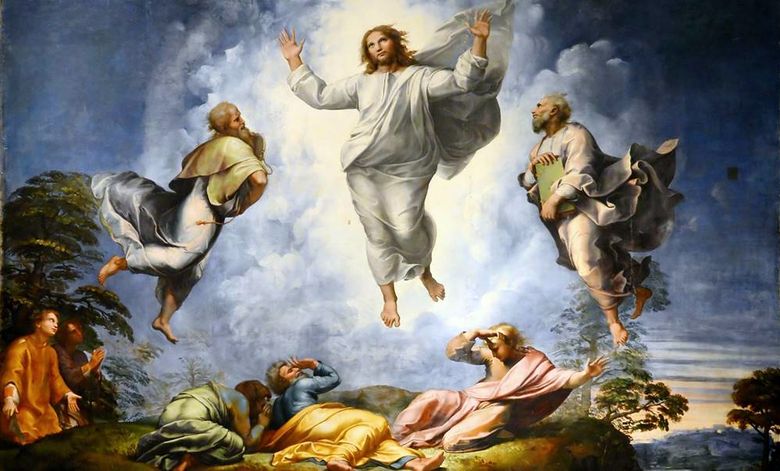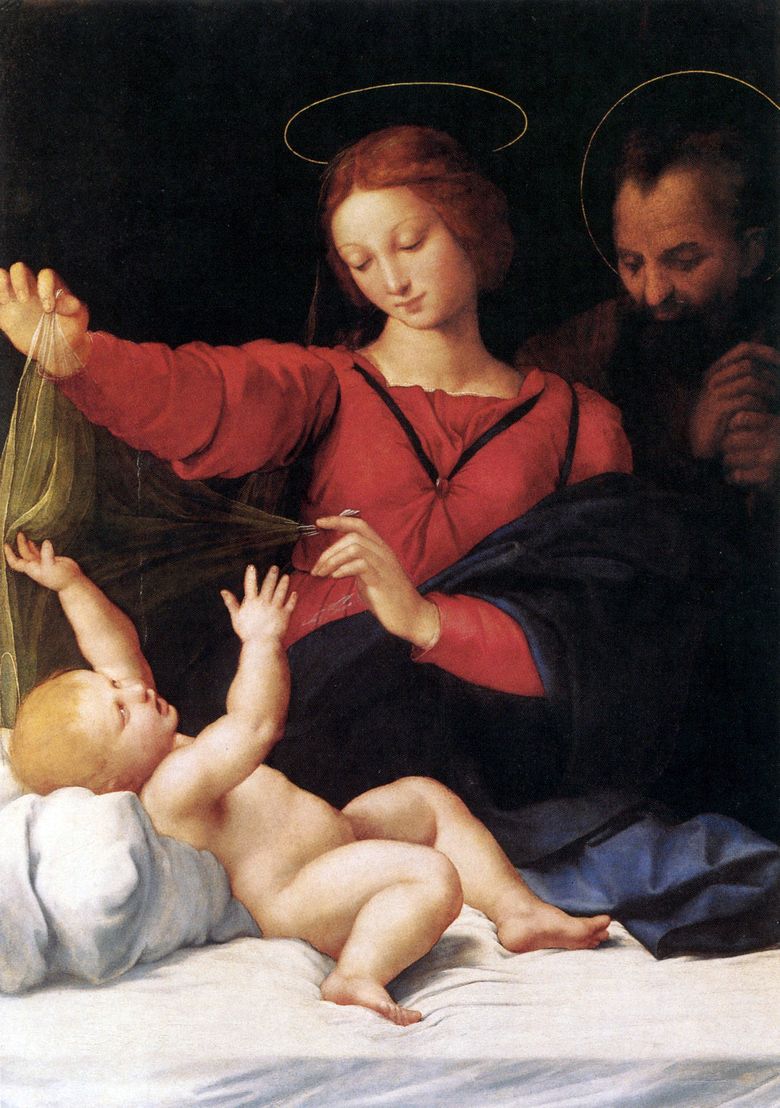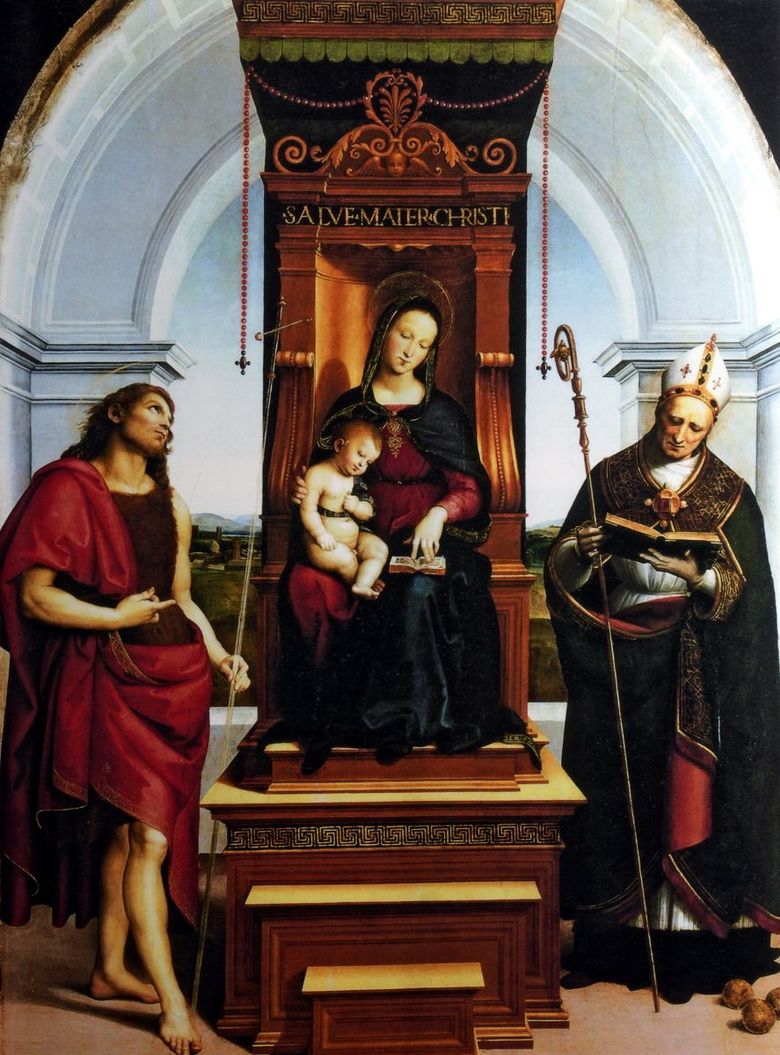
Rafael was a happy artist. Absorb abundance honorable and grand orders, famed for its admirers, he worked quickly and cheerfully. Do not work for him was bitter anguish. Modern Rafael humanists believed that in order to be understood by the people, the poet must speak the language of «vulgare». For the same purpose, some Renaissance artists turned to the old folk traditions and brighten their colors of his imagination.
The painting of the Madonna by Raphael phenomenon deceased Pope Julius II has become a phenomenon of its people, and about which it was told in ancient tales. In such legends found their expression of the aspirations of the people of justice, the desire and need for ordinary people to imagine a heavenly queen and patroness in the immediate vicinity. However, Rafael was not limited only retelling of the medieval legend.
In the history of the most famous works of Raphael still much shrouded in mystery. Some critics believe that his Maria almost lost the halo of sanctity. On her head a crown does not flicker, do not keep her brocade fabrics. On the contrary, her veil and cloak of smooth fabric, her feet bare, and in essence it is a simple woman. No wonder many conspicuous that the baby she is holding as generally keep their peasant. But this barefoot woman meet as queen – ruler of heaven.
Pope Sixtus withdrew before her tiara and carefully placed it in the corner. Earthly ruler as the
Magi before the Christmas manger, drew his forehead, and before the audience appears almost trembling with excitement the old man. Other researchers believe that in this solemn Madonna, on the contrary, there is nothing earth. This deity, clothed in human form. Her face still resembles the familiar features of Fornarina, but the features of the converted. Surrounded by a host of angels standing on clouds, Madonna is the world his divine Son.
Different generations, different people saw in the “Sistine Madonna” each his own. Some saw in it only the religious content, the other – hidden in her moral philosophy, others appreciated the artistic perfection in it. But these three aspects can not be separated from each other.
“Sistine Madonna” by Raphael created around 1516. By this time they had already written a lot of pictures with the image of Our Lady. Very young Raphael was famous as a wonderful and incomparable master poet image of Madonna. In the St. Petersburg Hermitage has a “Madonna Conestabile”, which was created by a seventeen year old artist.
The Pitti Gallery is his “Madonna of the chair,” at the Museum of the Prado – “Madonna with the fish” in the Vatican Pinakothek – “Madonna del Foligno”, others Madonna became treasures of other museums. But when it came time to write the main his work, Rafael left his disciples numerous works in the Vatican Palace to personally write to the abbey church of Saint Sixtus in Piacenza far altarpiece. Altarpiece then wrote on the blackboard, but that his Madonna Rafael wrote on canvas.
First, “The Sistine Madonna” was in a semi-circular choir of the abbey church, and the towering figure of Our Lady from afar seemed hovering in the air. In 1754, the painting was purchased by King Augustus III of Saxony and Dresden was brought to his residence. Courtyard of the Saxon electors paid for it 20 thousand sequins – a considerable sum in those days. And now, when visitors of the famous Galleries closer fit to the picture of stronger covers new impression. Virgin no longer hovering in the air, as it were, comes to meet you. Parapet pictures – the only barrier that separates the earthly world from the celestial world. As reality parted to the side green curtain, and Mary with the divine son in her arms is your gaze.
She goes, and fancies that now Our Lady of step over the parapet and set foot on the ground, but the moment it lasts forever. Madonna remains stationary, always ready to go down and always available. In the picture there is no earth, no sky, no familiar landscape or architectural decorations in depth. All space between the figures is filled with clouds, a thickened and dark bottom, more transparent and radiant at the top. Overweight senile figure of St. Sixtus, immersed in the heavy folds of golden-papal vestments, froze in solemn worship. His outstretched hand to us eloquently underlines the main idea of the painting – a phenomenon of Our Lady of the people.
On the other hand bent St. Barbara, and two figures like Mary support, forming a vicious circle around it. These figures, some called ancillary, minor, but if you remove them , or even just to change their position in space – immediately destroyed the harmony of the whole. It changes the meaning of the whole picture, and the very image of Mary. Madonna reverently and gently presses his chest son sitting in her arms. Neither the mother nor the child can not be presented separately from one another, their existence is possible only in indissoluble unity. Maria – intercessor human – bear to meet the people his son. In her lonely march expressed all that sad and tragic sacrifice, which is doomed to Our Lady.
The world of “Sistine Madonna” extraordinarily complicated, though, at first glance, in the picture, nothing portends trouble. And yet, the viewer pursues a sense of impending trouble. Fruity singing choir of angels filled the sky , and praising Mary. Not tears of ecstatic gaze of Our Lady of Sixtus kneeling humbly lowered eyes of St. Barbara. It seems that nothing threatens the peace of Mary and her son. But run-run alarming shadows on the folds of clothing and draperies. Clubs clouds under the feet of the Madonna, of course shine surrounding it and the Divine Child, promises a storm. All eyes existing pattern people pointing in different directions, and only Mary and divine baby look at us.
Raphael painted on his canvas a wonderful vision and makes the seemingly impossible. The whole picture is full of internal movement, illuminated by the light quivering as if a mysterious glow radiates the canvas itself. This light is barely glimmers, it shines, almost glows. And this condition before the storm is reflected on the face of the infant Christ, his face full of anxiety. He seemed to see the lightning of an approaching storm, in his harsh eyes can see the reflection of distant evils, for “not the world I brought to you, but a sword.”. He clung to his mother’s breast, but anxiously peering into the world.
It is said that the “Sistine Madonna” by Raphael wrote at the time, when he experienced severe grief. And because all my grief has put his face in the divine Madonna – most perfect embodiment of the ideal of Christianity. He created the most beautiful image of Our Lady, uniting it features the highest religious ideal with the highest humanity.
 Madonna of the Meadow by Raphael Santi
Madonna of the Meadow by Raphael Santi Transfiguration by Raphael Santi
Transfiguration by Raphael Santi School of Athens by Raphael Santi
School of Athens by Raphael Santi Madonna Loreta o Madonna del Velo – Rafael Santi
Madonna Loreta o Madonna del Velo – Rafael Santi Madonna dans le vert (Madonna del Prato) – Rafael Santi
Madonna dans le vert (Madonna del Prato) – Rafael Santi Transfiguration du Christ – Raphael Santi
Transfiguration du Christ – Raphael Santi Madonna Loreta ou Madonna del Velo – Rafael Santi
Madonna Loreta ou Madonna del Velo – Rafael Santi Madonna Ansidei – Rafael Santi
Madonna Ansidei – Rafael Santi